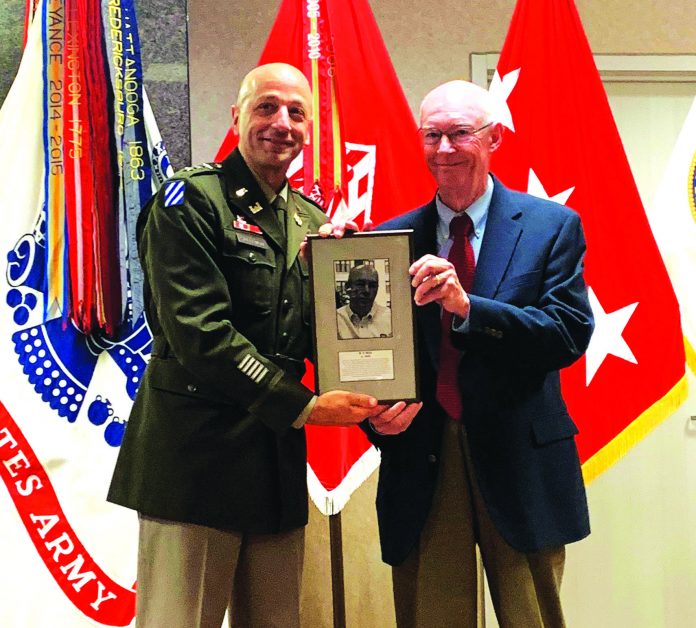
By Carol Vaughn — M.K. Miles III, whose family roots run deep on the Eastern Shore, was awarded the highest honor given to civilians by the Army Corps of Engineers in a ceremony Wednesday, June 29, in Washington, D.C.
Many people on the Eastern Shore know Miles as a historian and a genealogist, but this honor was about his 35-year career with the Corps.
Miles retired in September 2008.
Miles was inducted into the Army Corps of Engineers Gallery of Distinguished Civilians, including being presented his framed portrait to be hung in the gallery.
Miles during his career helped revolutionize engineering and navigational practices worldwide during the early development of Global Positioning System (GPS) technology.
Miles served from November 2006 through May 2007 as deputy chief of engineering and construction in the Civil Works Directorate at the Corps headquarters in Washington, D.C., where he was responsible for policy, program, and technical expertise in the execution of more than $10 billion of design and construction programs for the Army, the Air Force, the Department of Defense, and other federal agencies, as well as in more than 60 foreign nations.
Miles led a field organization of eight divisions, 41 districts, and around 15,000 employees.
During his career, Miles saw the introduction of the military GPS in the 1980s, which was intended for military tactical use at the time and had limited availability and low accuracy for civil uses.
Through his establishment of a surveying and mapping research and development program, techniques leading to much greater accuracy in the new technology were developed.
Miles also coordinated a partnership with the Coast Guard, enabling development of an inland electronic navigational charts system now used by virtually all commercial vessels on inland waterways.
“The technology significantly increased the safety of the inland navigation system, while reducing costs,” according to the nomination narrative.
His leadership in GPS technology also resulted in “numerous federal patents and partnerships with private corporations, such as Caterpillar, culminating in a new industry centered around machine guidance and control, so successful that it has become a routine system in daily use throughout the worldwide marine construction and heavy civil construction and earthmoving industries,” according to the nomination.
The new technology revolutionized high-resolution airborne mapping capability for military and civil applications and coastal engineering with Light Detection and Ranging (LIDAR) systems.
Miles was instrumental in establishing the Joint Airborne Lidar Bathymetry Technical Center of Expertise, a partnership among the Army Corps, the Navy, NOAA, and the U.S. Geological Survey.
Miles also promoted the introduction to field offices of the first multibeam acoustic depth measurement system, which greatly increased the accuracy and resolution of bottom mapping.
Miles “was an active proponent of CAD (computer-aided design), GIS (geographic information systems), and BIM (building information modeling), and a strong supporter of National Standards. Before any of the computing tools were widely recognized and were in use, he mandated data standards,” according to the nomination.
Before working at the Washington, D.C., headquarters, Miles worked in the Corps’ Norfolk District from 1973 to 1981.
He served as a second lieutenant in the U. S. Air Force from 1971 to 1973.
Miles earned a bachelor of science degree in civil engineering from Virginia Tech in 1971.
Among other awards, Miles is a recipient of the Silver Order of the de Fleury Medal, an award of the Army Engineer Association.
He also in 2007 was the first recipient of the Management Association for Private Photogrammetric Surveyors Public Service Award, given for contributions to the public and the geospatial profession in a government service role.
The Army Corps Gallery of Distinguished Civilians was established in 1955 and now includes around 100 members.
To be inducted, members must have served at least 10 years at Army Corps headquarters or the Office of the Chief of Engineers; served as an exemplary role model and mentor; accomplished their duties in an outstanding manner; developed new and improved methods and procedures which produced significant benefits to the Corps; and contributed substantially to the reputation and honor of the Corps, according to a memorandum about the induction ceremony.
Miles during comments at the induction ceremony noted his Eastern Shore ancestor, Col. Edmund Scarborough, born in 1617 in England and a prominent early Shore settler, was appointed Surveyor General of the Virginia colony, serving in that capacity from 1655 to 1670.
Scarborough came to Virginia around 1621 and settled on the Eastern Shore around 1628.
He represented the Accomac Shire in the Virginia House of Burgesses.
“I’m his ninth great-grandson and I’m a surveyor,” Miles said, adding, “…I’m really thankful for the opportunity to work with the Corps of Engineers for 35 years.”


